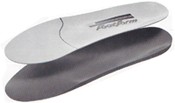The most common repetitive strain injury I see in my clinic is Plantar Fasciitis. The symptom that indicates a possible diagnosis of Plantar Fasciitis is pain in the heel on the bottom of the foot especially when taking the few first steps in the morning or after resting. Micro tears and resultant inflammation in the tissue at the connection point between the plantar fascia and heel bone are responsible for the pain. Resting at night, the plantar fascia repairs a little bit, then tears again in the morning with those first steps.
Most of us take 10,000 steps per day. Those steps constantly irritate the plantar fascia. The plantar fascia is part tendon and part soft tissue, the only structure like this in the body.
Though the pain of Plantar Fasciitis is felt in the heel, putting weight on the heel (or a strong heel strike) is not the cause of Plantar Fasciitis. Mistakenly, most people treat the problem with heel cushions. Though a person may feel relief with heel cushions, the true problem won't be addressed. The usual gait compensation is to walk on the toes. This causes a shortening of the calf muscles and more toe walking, creating a vicious cycle, resulting in chronic cases of plantar fasciitis. I've seen people in my clinic that have had chronic plantar fasciitis for years.
The true problem is a strain on the entire plantar fascia along the bottom of the foot. To reduce the strain, it's important to keep the heel down during the stride and to let the entire foot linger on the ground with every step, rather than walking primarily on the forefoot and toes.
Full foot orthotics and proper shoes along with gait and stance training will alleviate the strains that caused the Plantar Fasciitis. With the proper care and attention to gait, most cases improve dramatically in 6 weeks.
If you keep doing the same thing over and over, ten-thousand steps a day you will get the same result. Step by step, changing the habits you've developed in your stride, along with an excellent foot orthotic will promote healing of the plantar fascia.
Subscribe to:
Post Comments (Atom)









1 comment:
Hi Randall
I was wondering if you can tell what elements are needed for a generic insole that would bring comfort to a shoe wearer. What material would you use? by the way your blog is amazingly full of facts and I am enjoying readking each post
Post a Comment